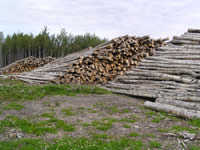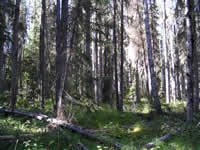| |
The circumpolar boreal forest is one of the largest intact forest ecosystems in the world representing approximately 25% of the remaining closed canopy forests (Shilts, 1999). The boreal forest is also a northern hot spot for biodiversity with over 70,000 species described within Canada alone (Government of Canada, 2005). These, along with many other overarching qualities emphasize the importance of reducing long term impacts on this region and ensuring its conservation for future generations.
However, these ecological benefits are paralleled by the high value of natural resource exploration within the Canadian boreal forest. As a result, exploration activity is highly evident within provinces such as Alberta where substantial oil and gas deposits, as well as timber allocations occupy the provincial land base (Schneider, 2002). This anthropogenic pressure has resulted in a high degree of fragmentation, threatening the persistence of biodiversity now and in the future (Schneider, 2002).

In addition to the direct disturbance of the forest habitat, there is a further level of fragmentation on these land bases which is not visible on traditional forest fragmentation maps. Edge effects result from the creation of anthropogenic forest edges, such as through forest harvesting, and have the potential to greatly increase the indirect fragmentation on the landscape (Murcia, 1995; Bradshaw, 1992). Research shows that edge effects can extend up to 50 metres into the remaining forest matrix(Murcia, 1995), and impact a variety of species (Pohl et al., 2007; Matlack, 1994; Peak, 2007). The resulting changes in microclimate and habitat structures within these edge effect zones can have serious consequences for biodiversity through increasing reproductive failure, and direct mortalities (Fahrig, 2001). Thus it is critical to have an accurate understanding of the impacts of edge effects in order to predict the true degree of habitat fragmentation within the boreal forest.
Although edge effects have been researched globally, there is still a substantial need to enhance our understanding of influences on edge effects ( Murcia, 1995), particularly those resulting from forest harvesting in the boreal forest (Stewart and Mallik, 2006). In addition, research into the impacts of edge effects on arthropods is lacking, limiting our understanding of the magnitude of edge effects on non-vertebrate components of biodiversity (Langor and Spence, 2006).

In order to enhance our understanding of edge effects and increase our ability to reduce habitat fragmentation, there are a series of critical baseline questions which must be addressed. The first of these is the question of how forest cover type impacts the extent of edge effects resulting from forest harvesting. The mixedwood composition of the boreal forest provides a unique ability to compare edge effects between cover types, while enabling all sites to experience similar environmental conditions as a result of their relative proximity. The second of these questions is the ability of edge effects to recover over time as the harvested forest regenerates. Very few studies have addressed this research question, and it currently limits our ability to model habitat fragmentation over time (Spence et al., 1996; Matlack, 1994). My study attempts to explore these research questions in a unique, and replicated research design.
The Study Objectives are to:
- Assess the extent of edge effects on ground beetles in the boreal forest
- Determine the effect of forest cover type on the extent of edge effects
- Assess whether edge effects exhibit signs of recovery as the adjacent harvest sites regenerate
Throughout the website, I have divided the results into two main sections 1) cover type effect and 2) age effect. The cover type effect section will present the results from objective 2, and the age effect section will address objective 3. Objective 1 will be addressed jointly by the two sections.
|
|